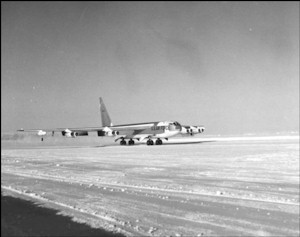The Airborne Alert Program Over Greenland |
 |
The nuclear overflights of Greenland occurred under U.S. Strategic Air Command's
Airborne Alert Indoctrination program. During the late-1950s and 1960s, the
United States maintained up to 12 nuclear-armed bombers airborne 24 hours a
day. The justification was fear of a possible Soviet surprise-attack that would
be capable of destroying a large portion of the U.S. strategic bomber force on
the ground before it get airborne. To prevent such a partial disarming of the
U.S. deterrent force, the Pentagon began building up an Airborne Alert Program
from the mid-1950s. The nuclear-armed program continued until under various code
names such as Head Start, Round Robin, and Chrome Dome until the day after the
Thule crash when the Pentagon ordered the nuclear weapons taken off the planes.
(Maps of different bomber routes are available in the right-hand bar).
Initially started in 1958 under the so-called Head Start program, the
full-scale Airborne Alert Indoctrination program known as Chrome Dome resulted
in at least two overflights Greenland a day with
nuclear weapons for almost a decade. Another route headed east across Spain into
the Mediterranean, and a third main route crossed the Pacific from Alaska toward
Japan. In addition to Chrome Dome flights, an additional nuclear-armed aircraft
was "parked" right above Thule Air Base where it circled continuously as part of
the Hard Head mission. The objective of Hard Head was to ensure continuous visual
surveillance of the Thule Air Base and its important BMEWS-radar, a critical element
for the U.S. response to a Soviet surprise-attack on North America. The bomber
that crashed on the ice off Thule Air Base on January 21, 1968, was on such a
Thule monitor mission, codenamed Butterknife V, when fire broke out onboard
bringing the aircraft and its four nuclear bombs down.
The Danish government was not informed about these overflights, but was aware
of frequent overflights by B-52 aircraft in general. Moreover,
 Danish government
officials were aware of occasional emergency landings by presumably
nuclear-armed B-52 bombers at Thule Air Base during the 1960 (see image). Denmark's
non-nuclear policy prohibited the presence of nuclear weapons in all parts of
the kingdom (including Greenland) and the Danish government stated repeatedly
during the 1960s that the United States was aware of this policy and there was
no reason to assume the policy was violated. Danish government
officials were aware of occasional emergency landings by presumably
nuclear-armed B-52 bombers at Thule Air Base during the 1960 (see image). Denmark's
non-nuclear policy prohibited the presence of nuclear weapons in all parts of
the kingdom (including Greenland) and the Danish government stated repeatedly
during the 1960s that the United States was aware of this policy and there was
no reason to assume the policy was violated.
U.S. military operations over Greenland were governed by the 1951 joint
agreement for the defense of Greenland, and the United States considered that it
was free to perform nuclear overflights under the arrangement, although the
treaty does not specifically mention nuclear weapons. During the 1960s,
nuclear-armed B-52s conducted emergency landings at Thule Air Base on several
occasions, something the Danish government was aware of, but given the emergency
involved, these cases were not considered violation of the non-nuclear policy.
When the Chrome Dome airborne alert program started in July 1961, the U.S.
Air Force told the Joint Chiefs of Staff that "in accordance with current
governmental understandings, there do not appear to be any restrictions on
overflights of Spain or Greenland with nuclear weapons." Even so the overflights
proved politically explosive. The crash happened less than 48 hours before a
national election in Denmark, and the U.S. Embassy warned the State Department
about the severe repercussions in light of the "special nuclear sensitivities"
in Denmark. In doing so
the Embassy emphasized that "it is iverative [sic] to
stress that [the] crashed plane was 'diverted' to Thule and not on [a] 'routine
flight to Thule'." And that lie became the official story and the root to more
than 30 years of nuclear rumors in U.S.-Danish relations.
Airborne Alert Aircraft carried a variety of nuclear bombs. The bomber
involved in the 1968-crash carried four B28 thermonuclear bombs. In general,
alert aircraft on Hard Head and Chrome Dome missions carried either four B28
bombs or two larger bombs such as the B36 (only on early flights) and B53. Due to the frequency of the
flights, four to eight nuclear bombs were continuously present in the
airspace over Greenland for almost a decade.
Following the accident in 1968 and the nuclear scandal, the carrying of
nuclear weapons on Airborne Alert Indoctrination flights was discontinued. The day
after the accident, Strategic Air Command ordered the nuclear weapons removed
from airborne alert aircraft. In December 1969, when SAC briefed the Danish
military liaison at Thule Air Base about the 1969 Thule Monitor mission, the
flight route avoided Greenland airspace even though the aircraft no longer
carried nuclear weapons. This was also the case in 1971 for the
Giant Lance
routes (see right-hand bar): Greenland airspace was avoided.
See the right-hand bar for maps of various bomber routes. ©
Hans M. Kristensen |
www.nukestrat.com |
2004
|

